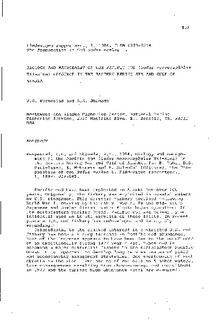| dc.contributor.author | Wespestad, Vidar G. | |
| dc.contributor.author | Shimada, Allen M. | |
| dc.date.accessioned | 2008-08-07T11:00:25Z | |
| dc.date.issued | 1984 | |
| dc.identifier.issn | 0333-2594 | |
| dc.identifier.uri | http://hdl.handle.net/11250/115146 | |
| dc.description.abstract | Pacific cod have been exploited in Alaska for over 100
years. Originally, the fishery was exploited in coastal waters
by U. S. fishermen. This domestic fishery declined following
World War I, ceasing by the early 1950's . In the mid-1950's
Japanese and Soviet distant water fleets began operations in
the northeastern Pacific Ocean. Pacific cod was primarily an
incidental species in the harvests of these fleets. In recent
years a U. S. cod fishery has redeveloped and is rapidly
expanding.
Coincidental to the renewed interest in a directed U. S. cod
fishery has been a strong increase in Pacific cod abundance.
Most of the increase appears to have been due to the occurrence
of an exceptionally strong 1977 year-class. Since cod is
becoming a major commercial fishery in the northeastern Pacific
Ocean it is important to develop long term estimates of yield
and accompanying management strategies. One shortcoming of such
efforts is the short time series of cod data i n Alaskan waters.
Some consequences resulting from above-average cod recruitment
in 1977 and the current high abundance level are examined. | en |
| dc.format.extent | 784896 bytes | |
| dc.format.mimetype | application/pdf | |
| dc.language.iso | eng | en |
| dc.publisher | Havforskningsinstituttet | en |
| dc.relation.ispartofseries | Flødevigen rapportserie | en |
| dc.relation.ispartofseries | 1, 1984 | en |
| dc.title | Biology and management of the Pacific cod (Gadus macrocephalus Tilesius) resource in the eastern Bering Sea and Gulf of Alaska. In: The propagation of cod Gadus morhua L.: an international symposium, Arendal, 14 - 17 June 1983 | en |
| dc.type | Conference object | en |
| dc.source.pagenumber | 819-846 | en |
